SYNOPSIS
!
SPOILER ALERT !
Victor Von
Doom is in search of Vibranium, the
"only metal ore which can absorb
vibrations", from which he plans to
build a deadly arsenal of the most
precise rockets the world has ever seen,
taking him one step closer to his
ultimate goal - world domination. The
problem with Vibranium is its rarity, but
Doom learns that the one location of
origin lies in the African kingdom of
Wakanda.
Using a
flying scanning device camouflaged as a
hawk Dr Doom explores the localities and,
once he has seen enough, boards his
latest means of transportation - a
"nuclear-powered excavator"
with which he tunnels his way to Wakanda
underneath the Mediteranean Sea.
Once in
Wakanda, Dr Doom finds that its most
famous native, the Black Panther, has
been alerted to his arrival. Focusing on
a part of the excavator which has
malfunctioned and is in need of repair,
Doom is taken by surprise and held at
gunpoint by the Black Panther...
In the
following issue, the fight between Dr
Doom and Black Panther ends in a
stalemate and Doom decides it is in his
best interest to leave Wakanda without
the Vibranium he came for - thinking that
the Black Panther might one day turn out
to be a useful ally...
|
|
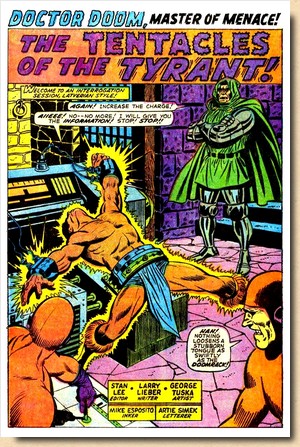 |
|
|
| |
| |
REVIEW & ANALYSIS
So-called
two-feature titles (i.e. a comic book essentially shared
by two different starring characters in their own
stories) were a key trait of Marvel Comics throughout the
1960s, but as was the case so often back then, it was
really a case of turning necessity into virtue.
|
| |
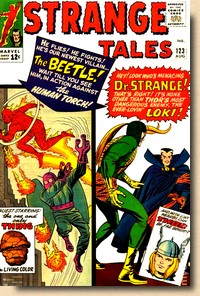 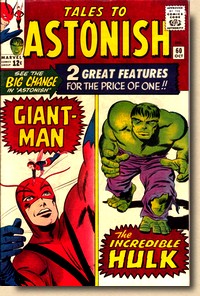
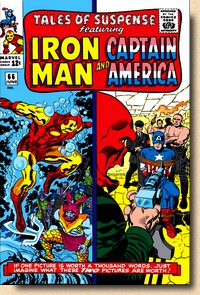
|
|
The need to split one
comic book between two main characters
actually had its roots back in 1957, when
Martin Goodman's new choice of
distributing company for his comics,
American News Company, went out of
business unexpectedly. Atlas Comics found
itself with no other choice than to
switch to Independent News, which however
was owned by National Periodical - who
also owned Goodman's rivals DC Comics. The
well-known outcome of this was that Atlas
and then Marvel Comics was limited by
contract to a monthly publishing output
of eight titles only (Cooke, 1998). As a result, Stan Lee
juggled with a mix of bi-monthlies,
cancelling Romance and Western titles and
turning Horror books into Superhero
titles in order to get the distribution
slots freed up for what was selling:
Marvel Comics brand new and different
approach to the genre featuring
"superheroes in the real
world".
Once the old
Atlas horror and mystery titles had been
given over to Marvel's new superheroes
(albeit retaining their original titles),
yet another way of approaching the
limited distribution problem was the
two-feature title.
This formula
had already been successfully tested
since Strange Tales #110 (July
1963) when Doctor Strange joined the
Human Torch (who would later be replaced
with Nick Fury as of issue #135, August
1965). In late 1964 Tales to Astonish
became a split book too, with issue #60
(October 1964) featuring the Hulk and the
previous solo star character Giant-Man
(replaced by Namor the Sub-Mariner as of
issue #70) in separate stories. Iron Man
followed suit and began to share his Tales
of Suspense a month later with
Captain America (issue #59, November
1964).
Marvel
Comics finally broke free from the
distribution constraints in 1967 when
Independent was purchased by
Kinney National Company and they got a
new deal. The result was an explosion of
new titles as established characters
finally could be given their own comic
book - Tales of
Suspense, Tales to Astonish and
Strange Tales alone split to become
six titles instead of three.
As the 1970s
rolled around, Marvel expanded yet again,
trying to come up
with new ideas and concepts.
"This
was that period (...) where Marvel
suddenly decided to put out a whole
bunch of books (...) it was just
constantly playing around with stuff,
trying to get market share (...) lots
of stuff came out in the '70s because
of this approach."(Roy
Thomas, in Cooke 2001)
Somewhat
ironically, Marvel - although for
entirely different reasons - ran into the
very same problem again: not having
enough title distribution slots.
"Evidence
suggests that Marvel was planning to
put out four new comics - The
Inhumans, Black Widow, Ka-Zar and Dr
Doom (...) But then it was decided
that Marvel was expanding too fast,
and there could only be two new mags;
so Stan decided it was time to try
out the two-feature title again (...)
so the Inhumans and Black Widow were
put into a new Amazing Adventures...
while Ka-zar and Dr Doom would divide
Astonshing Tales between them."
(Thomas, 2014)
|
|
|
| |
| And
so, Astonishing Tales #1 was launched with a
cover date of August 1970 as a revival of the classic
"double feature" format, accentuated by a name
which was of course very close to one of the best known
such titles from the Silver Age, namely Tales to
Astonish. But it wasn't just the split-feature
formula that made it special - Astonishing Tales also
had a brand new twist because it featured Ka Zar (who
basically was a bit like the Sub-Mariner, a good guy
sometimes forced by circumstances to battle it out with
one of Marvel's superheroes) and Dr Doom - an archvillain
and evil-doer by any standards. Although Doctor Doom was
dropped as feature character after Astonishing Tales #8
(October 1971), this was the first time that a major
publisher starred a villain in his own title (a few years
later DC would follow by giving the Joker his own book),
and this move was highly significant for the (yet to
happen at the time) early 1970s horror genre surge, as it
paved the way for the concept of having a character,
which is perceived as being basically evil, assume the
starring role of a comic book. In this respect, Dr Doom
paved the way for Marvel's
classic horror titles such as Tomb of
Dracula, Werewolf by Night and Ghost
Rider. Other than that, however, Astonishing
Tales didn't work that well - and neither did its
sister title Amazing Adventures.
| |
The
split-feature didn't sit as well
anymore as it had in the early to
mid-1960s Silver Age, and having
two characters in one book which
didn't really have much common
ground (be it Ka-Zar and Dr Doom
or the Inhumans and the Black
Widow) didn't help either. And on
top of that, the bi-monthly
publication meant that readers
had to wait an awfully long time
to read the next ten or so pages
instalment. If all of this wasn't
enough to disturb the flow of the
title, the Dr Doom stories were
plagued with Marvel's frequent
inability in the early 1970s to
provide consistency for both the
writing and the artwork - an indication
of the lack of cohesiveness the
House of Ideas displayed at the
time in both its approach of
thinking as well as its approach
of handling things when launching
a new title.
"Maybe
(...) if we'd kept on top of
everything - but (...) some
of it just kind of got away
from us (...) We were just
trying to do a little bit of
everything." (Roy
Thomas in Cooke, 2001)
|
|
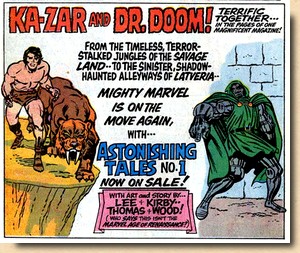
In-house
advertising for Astonishing
Tales #1, from the August
1970 Bullpen Bulletin
|
|
|
| |
| Roy
Thomas provided the first two plots before
handing over the writing to Larry Lieber for
three issues, who himself was then suceeded by
Gerry Conway for two issues. As for the artwork,
veteran artist Wally Wood did the first four
issues, followed by George Tuska and then Gene
Colan who both worked on two issues each. Given the
enormous potential offered by the character of Dr
Doom the series in Astonishing
Tales did rather poorly. Readers voiced
their disappointment about lukewarm plots and
uninspired storytelling through the letters
pages, and Astonishing Tales #6 is no
exception. Although the overall plot of Doom
invading Wakanda is promising, Larry
Lieber fills it with absurdities
(such as Doom's giant nuclear drill) and so much
exposition (Doom is constantly talking to himself
about what he is about to do and why) that the
story almost implodes and comes across as very
flat. And while Dr Doom was George
Tuska's favourite Marvel villain
(Cassell, 2005), the artwork is uneven inspite of
there only being ten pages. However, Tuska's rendition
of Doom's hawk-shaped "scanner" (think
drone in this day and age) provides some classic
visuals of the Latverian ruler.
|
|
| |
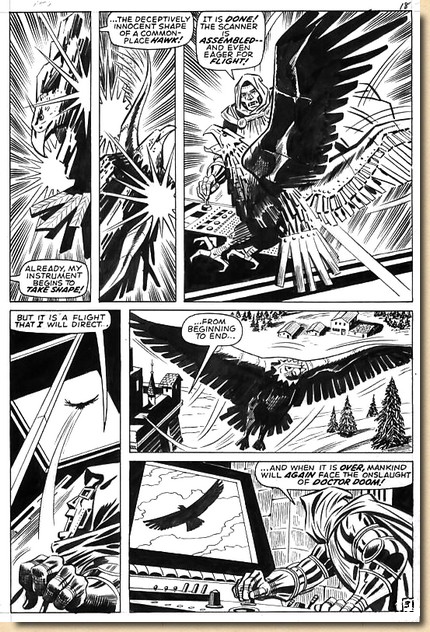 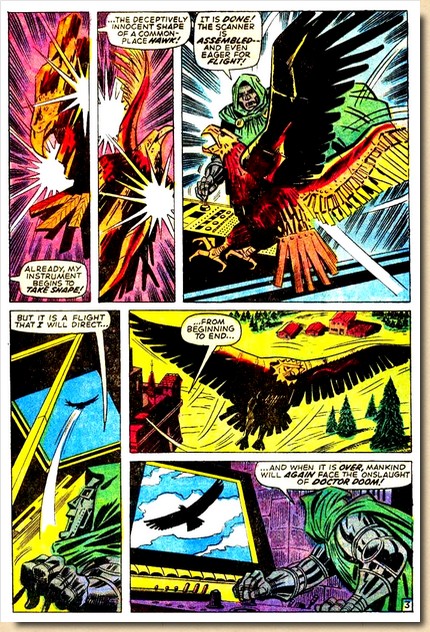
Original
artwork by George Tuska (pencils) and Mike Esposito
(inks) for page 3 of Astonishing Tales #6 (scanned from
the original)
and the same page as it appeared in print
|
| |
| In the end, even Doom's
huge popularity couldn't gloss over the feature's lack of
oomph. Gerry Conway and Gene Colan put in some very
atmospheric work over two issues, but it was already too
late, and Astonishing Tales was given over completely to Ka-Zar
as of issue #9 (December 1971) before the Colossus called
"It!" took over as of issue #21 (December
1973), followed by Deathlook (as of Astonishing
Tales #25, August 1974) who ran until the
cancellation of the title with issue #36 (July 1976) -
apart from the one-issue Guardians of the Galaxy
appearance in Astonishing Tales #29 (April
1975). The same fate befell Astonishing
Tales sister title, Amazing Adventures. The
Black Widow feature was dropped as of issue #9 (November
1971) and the title given over to Black Bolt &
Inhumans before the Beast (of X-Men fame), War of the
Worlds, Killraven, and then War of the Worlds again took
over. Amazing Adventures was cancelled after 39
issues in November 1976.
|
| |
| |
FACTS & TRIVIA
|
| |
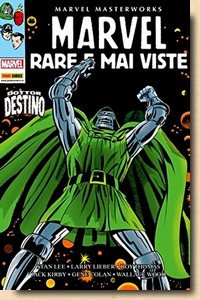 |
|
Astonishing Tales
#6 went on sale in the
US on 16 March 1971 and was also made
available to the UK market in mid-1971
with a pence
price variant
cover.
The
Black Panther's appearance carries over
from Avengers #58.
Astonishing Tales
#6 has been collected, together with
the entire run of Dr Doom features from
that title, in the 2014 Marvel
Masterworks Marvel Rarities
(Volume 1); it had previously only been
available as a black and white reprint in
Essential Super-Villain Team-Up
#1 (2004).
"The Tentacles
of the Tyrant!" was published in
December 1972 by Editoriale Corno for the
Italian market in I Fantastici
Quattro #45, where Dottor Destino
(as Dr Doom is called) had a backup slot
in the Fantastic Four's own book.
The Dr Doom story
from Astonishing
Tales #6 was again made available
for Italian readers in September 2016
when Panini Italy published their edition
of the Marvel Masterworks Rarities.
|
|
|
| |
|
| |
| BIBLIOGRAPHY CASSELL Dewey (2005)
The Art of George Tuska, TwoMorrows
COOKE Jon
B. (1998) "Stan the Man & Roy the Boy: A
Conversation Between Stan Lee and Roy Thomas", in Comic Book Artist #2,
Summer 1998
COOKE Jon B.
(2001) "Son of Stan:
Roy's Years of Horror", in Comic Book
Artist #13
THOMAS Roy
(2014) "Introduction", in Marvel
Masterworks: Marvel Rarities Volume 1
|
| |
| |
The illustrations
presented here are copyright material.
Their reproduction for the review and
research purposes of this website is
considered fair use
as set out by the Copyright Act of 1976,
17 U.S.C. par. 107.

(c) 2017-2018
|
|
|
|